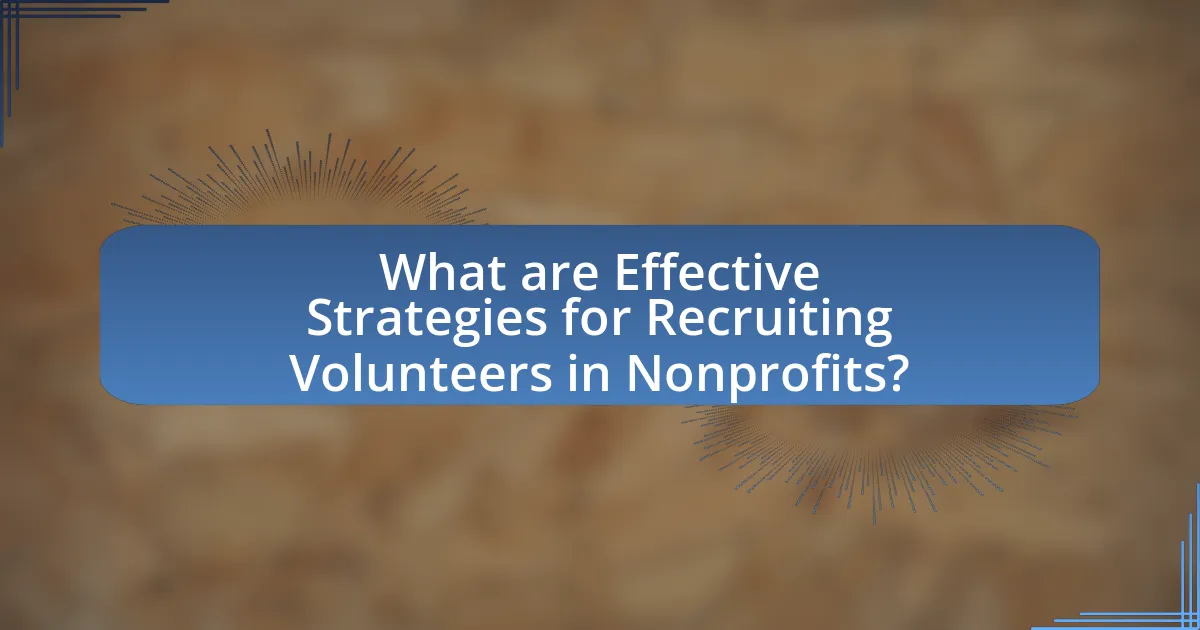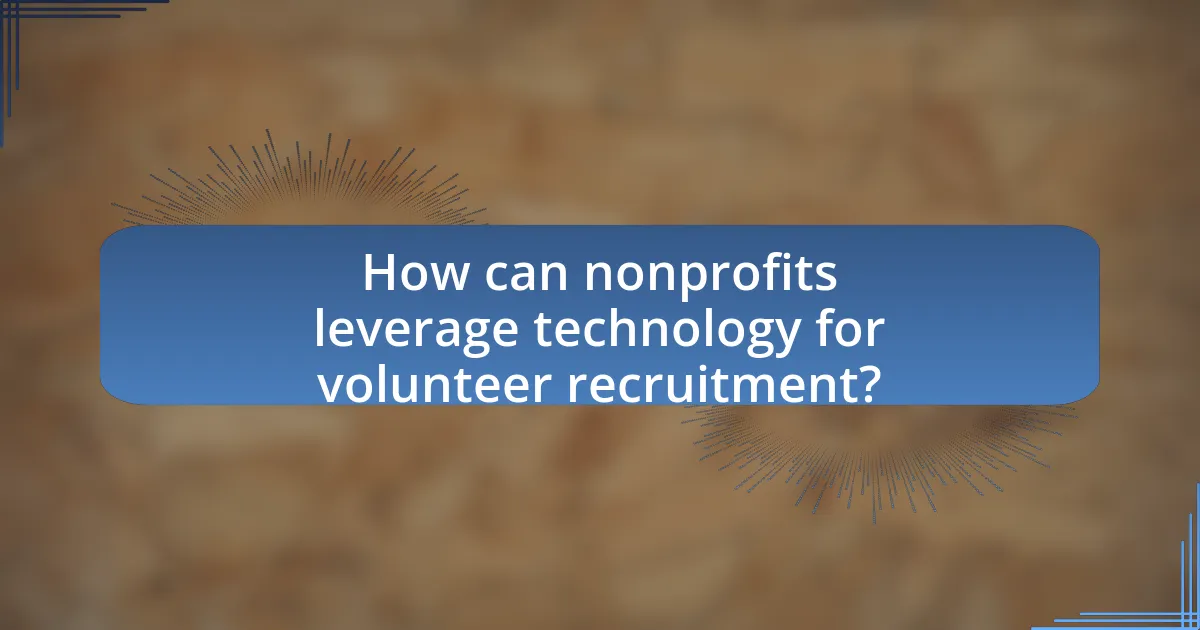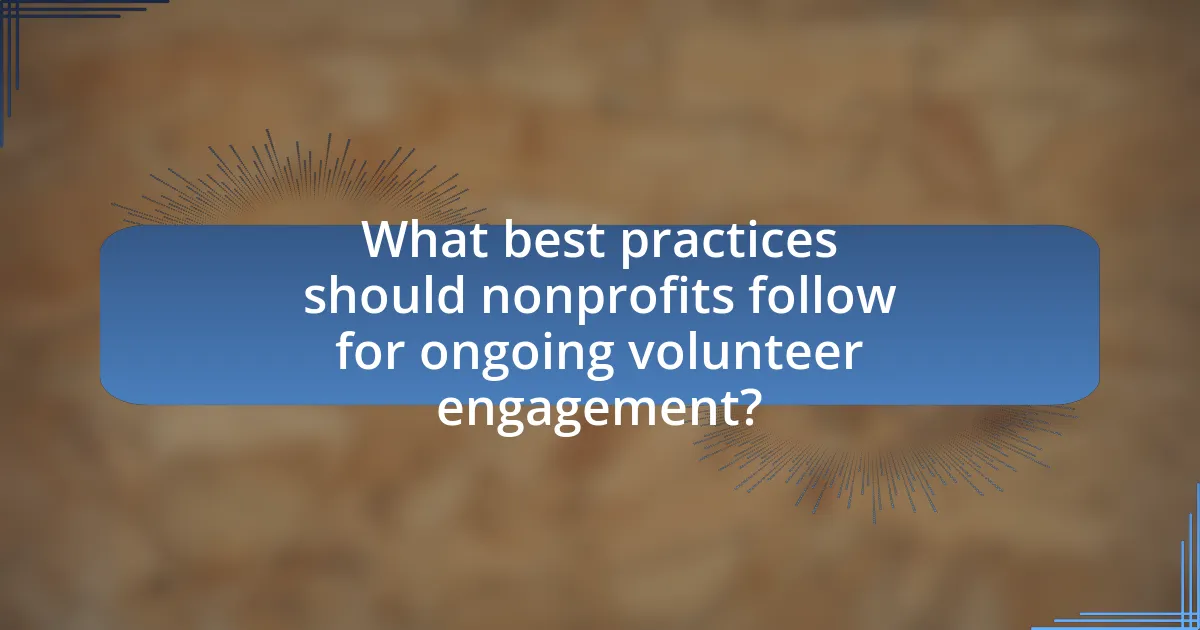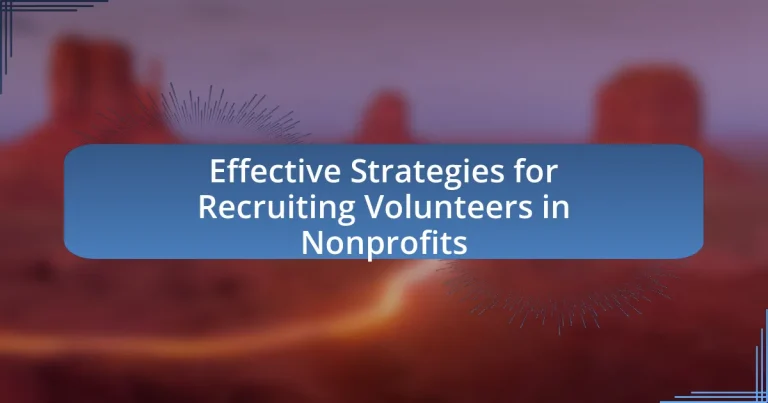The article focuses on effective strategies for recruiting volunteers in nonprofit organizations, emphasizing the importance of volunteer recruitment for fulfilling missions and serving communities. Key strategies include leveraging social media, building community partnerships, and creating engaging volunteer experiences to enhance retention. It discusses the impact of volunteers on nonprofit operations, challenges faced in recruitment, and best practices for ongoing engagement. Additionally, the article highlights the significance of clear communication, targeted outreach, and the role of technology in streamlining the recruitment process.

What are Effective Strategies for Recruiting Volunteers in Nonprofits?
Effective strategies for recruiting volunteers in nonprofits include leveraging social media, building community partnerships, and creating a compelling volunteer experience. Social media platforms like Facebook and Instagram can reach a broad audience, with 79% of adults using these platforms, making them effective for outreach. Community partnerships with local businesses and organizations can enhance visibility and credibility, as collaboration often leads to shared resources and networks. Additionally, providing a positive and engaging volunteer experience increases retention and encourages word-of-mouth referrals, which is crucial since studies show that personal recommendations are one of the most effective ways to recruit volunteers.
Why is volunteer recruitment important for nonprofits?
Volunteer recruitment is crucial for nonprofits because it directly impacts their ability to fulfill their missions and serve their communities. Nonprofits often rely on volunteers to provide essential services, support programs, and extend their reach without incurring significant costs. According to the National Council of Nonprofits, volunteers contribute an estimated $193 billion worth of services annually, highlighting their vital role in sustaining nonprofit operations. Effective volunteer recruitment ensures that organizations have the necessary human resources to achieve their goals, engage with the community, and drive social change.
What impact do volunteers have on nonprofit organizations?
Volunteers significantly enhance nonprofit organizations by providing essential manpower and resources that drive mission fulfillment. Their contributions often lead to increased service capacity, allowing nonprofits to reach more beneficiaries and implement programs more effectively. For instance, a study by the Corporation for National and Community Service found that volunteers contribute an estimated $184 billion annually to the U.S. economy, demonstrating their financial and operational impact. Additionally, volunteers bring diverse skills and perspectives, fostering innovation and community engagement, which are crucial for the sustainability and growth of nonprofit initiatives.
How does effective recruitment influence volunteer retention?
Effective recruitment significantly enhances volunteer retention by ensuring that individuals are well-matched to roles that align with their skills and interests. When organizations implement targeted recruitment strategies, they attract volunteers who are genuinely passionate about the mission, leading to higher satisfaction and commitment levels. Research indicates that organizations with structured recruitment processes experience a 25% increase in volunteer retention rates, as these processes foster a sense of belonging and purpose among volunteers. By clearly communicating expectations and providing adequate training during recruitment, nonprofits can further solidify volunteers’ engagement, reducing turnover and promoting long-term involvement.
What challenges do nonprofits face in recruiting volunteers?
Nonprofits face several challenges in recruiting volunteers, including limited resources, competition for attention, and lack of awareness about their missions. Limited resources hinder nonprofits from effectively marketing their volunteer opportunities, making it difficult to reach potential volunteers. Additionally, many organizations compete for the same pool of volunteers, which can dilute interest and engagement. A study by the Corporation for National and Community Service found that 63 million Americans volunteered in 2017, indicating a significant potential volunteer base, but many individuals remain unaware of specific nonprofit needs or how to get involved. These factors collectively complicate the recruitment process for nonprofits.
How do resource limitations affect volunteer recruitment?
Resource limitations significantly hinder volunteer recruitment by restricting the ability of organizations to effectively promote opportunities and engage potential volunteers. Nonprofits often rely on limited budgets for outreach efforts, which can result in reduced visibility in the community and fewer applicants. For instance, a study by the National Council of Nonprofits found that organizations with fewer resources are less likely to utilize digital marketing strategies, which are essential for reaching a broader audience. Additionally, limited staff capacity can lead to inadequate follow-up with interested individuals, further diminishing recruitment efforts.
What misconceptions do potential volunteers have about nonprofits?
Potential volunteers often believe that nonprofits operate with abundant resources and staff, leading to the misconception that their contributions are not needed. In reality, many nonprofits function with limited budgets and rely heavily on volunteer support to fulfill their missions. According to the National Council of Nonprofits, approximately 63 million Americans volunteer each year, demonstrating the critical role volunteers play in sustaining nonprofit operations. This highlights the importance of volunteer involvement in addressing community needs and advancing organizational goals.
What are the key elements of a successful volunteer recruitment strategy?
A successful volunteer recruitment strategy includes clear communication of the organization’s mission, targeted outreach, and a positive onboarding experience. Clear communication ensures potential volunteers understand the impact of their contributions, which can increase motivation and engagement. Targeted outreach involves identifying and connecting with specific demographics that align with the organization’s goals, enhancing the likelihood of attracting suitable candidates. A positive onboarding experience fosters retention by making volunteers feel welcomed and valued, which is supported by research indicating that organizations with structured onboarding processes see a 50% increase in volunteer retention rates.
How can nonprofits define their volunteer needs effectively?
Nonprofits can define their volunteer needs effectively by conducting a thorough assessment of their organizational goals and the specific tasks required to achieve them. This involves identifying the skills and time commitments necessary for various roles, which can be determined through surveys, interviews, or focus groups with current staff and volunteers. Research indicates that organizations that clearly outline their volunteer roles and expectations are more successful in attracting suitable candidates, as evidenced by a study from the Corporation for National and Community Service, which found that clear role definitions lead to higher volunteer retention rates.
What role does branding play in attracting volunteers?
Branding plays a crucial role in attracting volunteers by creating a strong, recognizable identity that resonates with potential supporters. A well-defined brand communicates the mission, values, and impact of the organization, making it more appealing to individuals who want to contribute to meaningful causes. For instance, research by the Nonprofit Marketing Guide indicates that organizations with a clear brand strategy are 60% more likely to attract volunteers, as they effectively convey their purpose and foster trust. This connection between branding and volunteer engagement highlights the importance of a cohesive brand message in driving recruitment efforts.

How can nonprofits leverage technology for volunteer recruitment?
Nonprofits can leverage technology for volunteer recruitment by utilizing online platforms and social media to reach a broader audience. These tools enable organizations to create targeted campaigns that attract potential volunteers based on their interests and skills. For instance, platforms like VolunteerMatch and Idealist allow nonprofits to post opportunities that can be easily discovered by individuals looking to volunteer. Additionally, social media channels such as Facebook and Instagram can be used to share engaging content about volunteer experiences, which can inspire others to get involved. According to a 2021 report by the Corporation for National and Community Service, 63 million Americans volunteered, indicating a significant pool of potential recruits that nonprofits can tap into through effective online outreach.
What online platforms are most effective for recruiting volunteers?
The most effective online platforms for recruiting volunteers include VolunteerMatch, Idealist, and social media platforms like Facebook and LinkedIn. VolunteerMatch connects organizations with individuals seeking volunteer opportunities, boasting over 1.5 million registered users and facilitating more than 1 million volunteer connections annually. Idealist serves as a comprehensive resource for nonprofit jobs and volunteer opportunities, attracting a diverse audience interested in social impact. Social media platforms, particularly Facebook, allow organizations to reach a broad audience through targeted ads and community engagement, while LinkedIn provides a professional network for recruiting skilled volunteers. These platforms have proven successful in increasing volunteer engagement and participation rates.
How can social media enhance volunteer recruitment efforts?
Social media can enhance volunteer recruitment efforts by providing a platform for organizations to reach a wider audience quickly and effectively. Through targeted advertising and engaging content, nonprofits can connect with potential volunteers who share similar interests and values. For instance, a study by the Pew Research Center found that 69% of adults in the U.S. use social media, making it a valuable tool for outreach. Additionally, social media allows organizations to showcase their mission and impact, fostering a sense of community and encouraging individuals to get involved. By leveraging hashtags and community groups, nonprofits can further amplify their message and attract volunteers who are passionate about their cause.
What tools can streamline the volunteer application process?
Online volunteer management platforms, such as VolunteerMatch and SignUpGenius, can streamline the volunteer application process. These tools provide user-friendly interfaces for potential volunteers to submit applications, track opportunities, and communicate with organizations. For instance, VolunteerMatch connects nonprofits with volunteers based on interests and skills, facilitating a more efficient matching process. Additionally, platforms like SignUpGenius allow organizations to create sign-up sheets that simplify scheduling and coordination, reducing administrative burdens. By utilizing these tools, nonprofits can enhance their recruitment efforts and improve the overall experience for volunteers.
How can nonprofits create engaging volunteer opportunities?
Nonprofits can create engaging volunteer opportunities by aligning tasks with volunteers’ skills and interests, ensuring meaningful contributions. When organizations assess the strengths and passions of potential volunteers, they can tailor roles that resonate with individuals, leading to higher satisfaction and retention rates. Research indicates that volunteers who feel their work is impactful are more likely to remain committed; for instance, a study by the Corporation for National and Community Service found that 63% of volunteers reported a sense of purpose when their tasks matched their skills. Additionally, providing training and support enhances the volunteer experience, fostering a sense of community and belonging, which further engages volunteers in their roles.
What types of volunteer roles are most appealing to potential recruits?
The types of volunteer roles most appealing to potential recruits include positions that offer direct community impact, skill development, and flexible time commitments. Research indicates that roles such as mentoring, event planning, and hands-on service projects attract individuals seeking meaningful engagement and personal growth. For instance, a study by the Corporation for National and Community Service found that volunteers are more likely to participate when they can see the tangible results of their efforts, such as in community clean-up initiatives or educational programs. Additionally, roles that allow for skill enhancement, like marketing or project management, appeal to those looking to build their resumes while contributing to a cause.
How can nonprofits communicate the impact of volunteer work?
Nonprofits can communicate the impact of volunteer work by utilizing data-driven storytelling that highlights specific outcomes achieved through volunteer efforts. For instance, they can present statistics showing the number of hours volunteered, the number of beneficiaries served, and the tangible results of projects completed, such as meals provided or community improvements made. Research from the Corporation for National and Community Service indicates that volunteers contribute an estimated $193 billion annually to the U.S. economy, underscoring the significant value of their work. By sharing testimonials from volunteers and beneficiaries, nonprofits can further illustrate the personal and community transformations resulting from volunteer engagement, making the impact relatable and compelling.

What best practices should nonprofits follow for ongoing volunteer engagement?
Nonprofits should implement regular communication, recognition programs, and opportunities for skill development to ensure ongoing volunteer engagement. Regular communication keeps volunteers informed and connected, fostering a sense of belonging and commitment. Recognition programs, such as awards or public acknowledgments, enhance volunteer motivation and satisfaction, as studies show that recognition significantly boosts retention rates. Additionally, providing opportunities for skill development not only enhances volunteers’ capabilities but also aligns their personal growth with the organization’s mission, leading to a more engaged and dedicated volunteer base.
How can nonprofits maintain relationships with volunteers after recruitment?
Nonprofits can maintain relationships with volunteers after recruitment by implementing regular communication, recognition programs, and opportunities for further engagement. Regular communication, such as newsletters or personal check-ins, keeps volunteers informed and connected to the organization’s mission. Recognition programs, including awards or public acknowledgments, enhance volunteers’ sense of value and belonging. Additionally, providing opportunities for further engagement, such as training sessions or leadership roles, fosters a deeper commitment and connection to the nonprofit. Research indicates that organizations with strong volunteer engagement strategies see a 50% increase in volunteer retention rates, demonstrating the effectiveness of these methods.
What strategies can be used to recognize and reward volunteers?
To recognize and reward volunteers, organizations can implement strategies such as public acknowledgment, personalized thank-you notes, and providing tangible rewards. Public acknowledgment can take the form of recognition events or features in newsletters, which not only highlight individual contributions but also foster a sense of community. Personalized thank-you notes add a personal touch, making volunteers feel valued and appreciated for their specific efforts. Tangible rewards, such as gift cards or small tokens of appreciation, can further incentivize volunteer participation and enhance their overall experience. Research indicates that recognition significantly boosts volunteer retention rates, with studies showing that organizations that actively recognize their volunteers see a 50% increase in volunteer satisfaction and commitment.
How can feedback from volunteers improve future recruitment efforts?
Feedback from volunteers can significantly enhance future recruitment efforts by identifying strengths and weaknesses in the current recruitment process. When volunteers share their experiences, organizations can pinpoint what attracted them to volunteer, such as specific messaging or outreach methods, and replicate those successful strategies. Additionally, constructive criticism regarding the onboarding process or volunteer engagement can lead to improvements that make the organization more appealing to potential recruits. For instance, a study by the Corporation for National and Community Service found that organizations that actively seek and implement volunteer feedback see a 20% increase in volunteer retention rates, which directly correlates with more effective recruitment efforts. This data underscores the importance of integrating volunteer feedback into recruitment strategies to create a more effective and appealing volunteer program.
What practical tips can nonprofits implement for effective volunteer recruitment?
Nonprofits can implement targeted outreach strategies to enhance volunteer recruitment effectively. Utilizing social media platforms allows organizations to reach a broader audience, as 79% of volunteers are motivated by social media engagement. Additionally, creating a compelling volunteer job description that clearly outlines roles and expectations can attract suitable candidates. Engaging current volunteers in recruitment efforts can also be beneficial; studies show that referrals from existing volunteers lead to higher retention rates. Lastly, hosting informational events or open houses provides potential volunteers with firsthand insights into the organization’s mission and culture, increasing their likelihood of joining.
How can nonprofits tailor their messaging to different demographics?
Nonprofits can tailor their messaging to different demographics by understanding the unique values, preferences, and communication styles of each group. For instance, younger audiences may respond better to digital platforms and social media campaigns that emphasize social justice and community impact, while older demographics might prefer traditional communication methods like newsletters or direct mail that highlight the organization’s history and achievements. Research shows that targeted messaging increases engagement; a study by the Pew Research Center found that 72% of millennials prefer personalized content that reflects their interests. By segmenting their audience and customizing their messages accordingly, nonprofits can enhance their outreach effectiveness and volunteer recruitment efforts.
What are the most common mistakes to avoid in volunteer recruitment?
The most common mistakes to avoid in volunteer recruitment include unclear role descriptions, lack of engagement, inadequate training, and poor communication. Unclear role descriptions lead to confusion about expectations, which can deter potential volunteers. Lack of engagement during the recruitment process can result in a loss of interest, as candidates may feel undervalued. Inadequate training can leave volunteers feeling unprepared and unsupported, ultimately affecting retention rates. Poor communication can create misunderstandings and frustration, making it essential to maintain open lines of dialogue throughout the recruitment process. These mistakes can significantly hinder the effectiveness of volunteer recruitment efforts in nonprofits.


